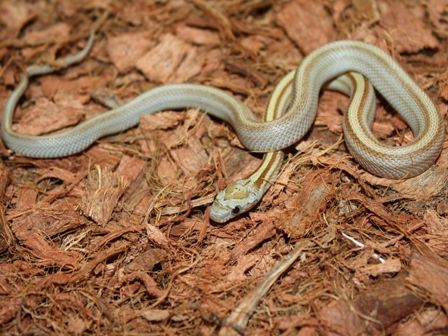Opinions . . . .
I believe they are Striped Super Jungle Corns, with as near 100% Corn Snake blood as they can get.
I think Tesseras are the most exciting addition to our Corn Snake gene pool EVER! The way we got them is unfortunate, but they produce Corn Snake combines that we have never seen before, and improve all other combines.
If anybody really believes that our general Corn Snake gene pool is pure corn, you are living a fantasy.
Joe:
I don't frequent the forums, so perhaps you already posted the evidence that Tesseras are inter-species hybrids.
In lieu of DNA evidence, all of our observations are just our personal opinions. If Mike had not admitted he used Gray Snows (Gray Rat X Snow Corn) to make the first generation of Ultramels, we'd all still say they wreak of characteristics and genetic productions unlike what we have seen in "pure" corns. One could say the same about Cinder, Sunkissed, and other mutations in corn snakes, but without empirical evidence (nDNA), each of us is left to our own opinions. Personally, I think Tesseras SMACK of hybrid origins, but other than what my eyes tell me, I have only the word of the person who sent the first reverse trio to Graham Criglow - saying that he bred a Striped Corn to an Okeetee Corn. That Striped "corn" had to be a striped-type Tessera for him to get four Tesseras in the first generation. The things we see in the Tessera mutation are so incredibly atypical for mutations in corns, I too question the heritage of Tessera Corns, but gene mutations are capable of products far beyond what we see in Tesseras. You already know that most North American colubrids are closely genetically related. I know guys 20 years ago who bred Amel corns to Albino California Kings and got all Albino progeny. That "
indicates" that corns and Cal Kings are cousins. Therefore, is it not possible that mutations would be related between two such species? It's practical to presume that most of the mutations demonstrated in serpents today were in the genome of a common serpent ancestor millions of years ago, so it's no stretch of the imagination to deduce that since we see Albinos, Axanthics, Melanistics, and myriad other gene mutations in most snake species, whatever can affect the phenotype of one species, can affect another WITHOUT being a result of a recent hybridization?
Like you, the crazy genetic impacts imposed by the Tessera mutation are too good to be true. I'd be the first to suspect they are the result of alien genes from a different species, since hybridization often brings such oddities to light, but I have no evidence to support such a theory. It's not enough to say, "looks like something I saw in California Kings". Imagine how dramatic the first Motley corn mutant was to breeders and keepers back in the 1960s? If people had regularly been performing inter-species hybridizations in herpetoculture back then, surely the Motley would have been such a hybrid suspect?
They call them "opinions" because they are subjective and lack evidence. If someone has definitive nDNA evidence to say that Cinders, Tesseras, Ultras, or other gene mutations demonstrated in corns are/are not borrowed from other species or a direct result of inter-species hybridization, the result is not opinion, but fact. You, me, and everyone else is entitled to their opinions (based on them saying "that looks like something I saw in a California King once" but that in and of itself does not render the conclusion that is must therefore be a California King Snake hybrid.
I'm fully aware that propaganda campaigns require constant bombardment of ideas and theories so this is not directed toward your constant referral to Tesseras as hybrids. It's just a reminder that anything we say is just a theory or opinion in the absence of hard evidence. Again, what I see in the Tessera mutations (and more importantly, the collateral non-Tessera- homozygote siblings) reminds me of inter-species hybridization. Thankfully, we're not talking about thoroughbred animals worth millions of dollars. We're dealing with hobby corns that are constantly bred to entertain people. I'm very much against intentional hybridization of any reptiles, but if we find out one day that Tesseras are indeed the result of hybridization with California Kings, I doubt everyone is going to throw all their Tesseras (and related non-Tesseras) in the freezer. Once such stains are in the genome, they're impossible to get out. Just like Dachshunds are the selective-breeding result of changing wolf genes, even if the genetic stain of wolves is not evident in present-day Dachshunds, it's always there. IF it is discovered that Cinder, Sunkissed, Tessera and other mutations owe their genetic oddities to other species, they're in the hobby to stay. I realize your campaign is to encourage people not to breed Tesseras, but at the end of the day--like it or not--Tesseras are not going away. Calling them Jungle corns should perhaps be qualified by a claim that it is not common knowledge (because there is no DNA evidence) but your personal opinion - based on having seen so many hybrids between California Kings and Corns. Without it, some readers who are new to the hobby may presume that you actually presented evidence to support your "opinions" somewhere on the forums. Personally, all the Jungle Corns I've seen and had over the decades did not genetically behave like the Tesseras at all.
Just my opinion.





















































